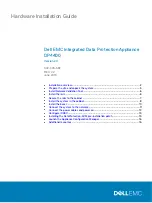
1MRS 751005-MUM
Arc Protection Module
Operator’s Manual
REA 105
7
4.
Description of operation
4.1.
Light detection
The switch SG1/4 (Sensor ON/OFF) is used for selecting the sensor fibre.
The light captured by the sensor fibre is amplified and compared either to an
automatic or a manual reference level. Once the reference level has been exceeded,
a light signal is generated and the signal relay (Light) is activated for about 0.5
second. In a trip situation, the central unit REA 101 or the REA 105 unit itself
provides information about the tripping, and the signal relay is locked in the active
state. If no tripping occurs, the relay resets.
The SG1/3 switch (Automatic light ref. level ON/OFF) is used for selecting the
automatic or manual reference level. The unit itself forms the automatic reference
level according to the present backlight intensity measured by the sensor fibre. The
potentiometer “Light Ref. Level Adj.” on the front panel is used for setting the
manual reference level.
The sensor fibre is monitored by sending a test pulse through the fibre. Unless the
test pulse is received at regular time intervals at the other end of the loop, the sensor
fault LED “Fault” and the IRF indicator LED “IRF” are activated.
Condition monitoring of the sensor fibre can be deactivated with the switch SG1/8
(Sensor supervision deactivation ON/OFF), in which case a radial, i.e. a terminating,
fibre can be used.
When the switch SG1/5 (Light to port IN1 ON/OFF) is in the OFF position, no light
signal is transmitted to the REA 101 unit located in the direction of the port IN1, and
the REA 105 extension unit alone carries out tripping if the REA 101 unit delivers
an overcurrent signal at the same time.
When the switch SG1/5 is in the ON position, the light signal is transmitted to the
central unit REA 101. Both the REA 105 and the REA 101 unit trip if the overcurrent
signal is active.
Delayed tripping by REA 101 is explained in section “Circuit-breaker failure
protection”.
The REA 105 unit does not send a light signal to the port IN2.
4.2.
Trip output
The trip output contains two high-speed, galvanically isolated IGBT semi-conductor
outputs (HSO1 and HSO2). These outputs can be used in DC and AC circuits. The
control signal of the outputs is activated if the unit detects light and the central unit
REA 101 delivers an overcurrent signal, provided the operating voltage fault signal
is inactive.
Once the central unit REA 101 performs tripping, all the REA 105 extension units
connected to it trip as well. When the REA 105 trips, the outputs remain in the active
state.
The outputs are reset by pressing the Reset push-button or via the RESET input of
the central unit.
www
. ElectricalPartManuals
. com
Содержание REA 105
Страница 1: ...REA 105 Arc Protection Module Operator s Manual w w w E l e c t r i c a l P a r t M a n u a l s c o m ...
Страница 2: ...w w w E l e c t r i c a l P a r t M a n u a l s c o m ...
Страница 21: ...w w w E l e c t r i c a l P a r t M a n u a l s c o m ...
Страница 22: ...w w w E l e c t r i c a l P a r t M a n u a l s c o m ...
Страница 23: ...w w w E l e c t r i c a l P a r t M a n u a l s c o m ...





































